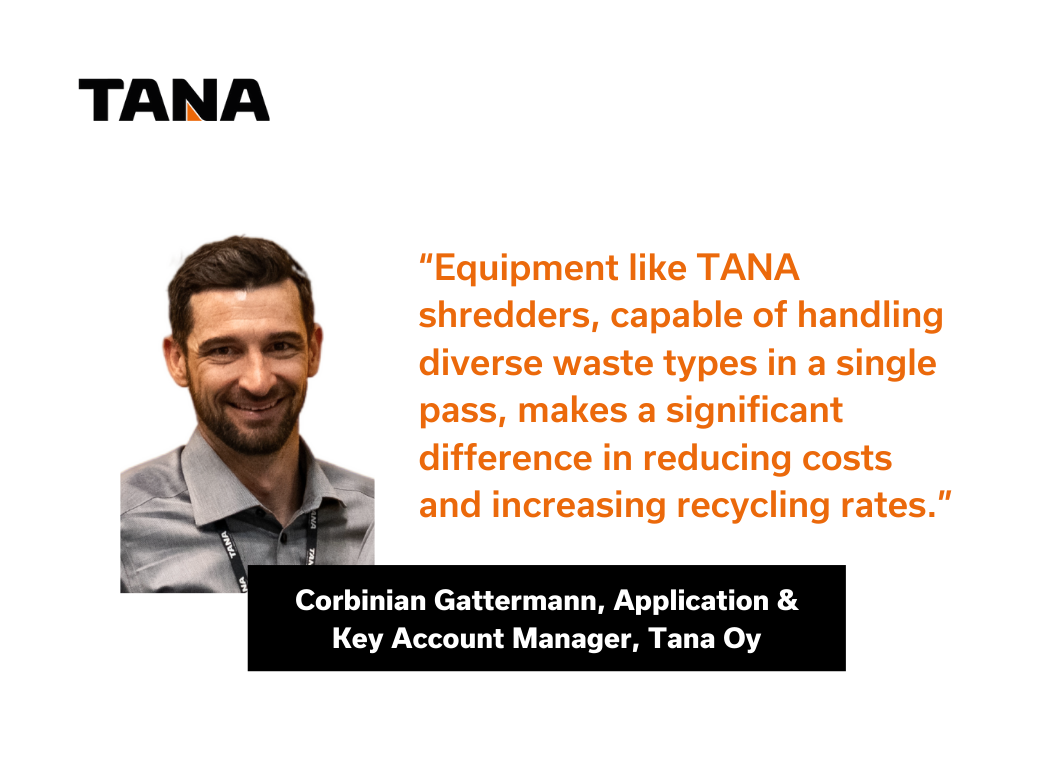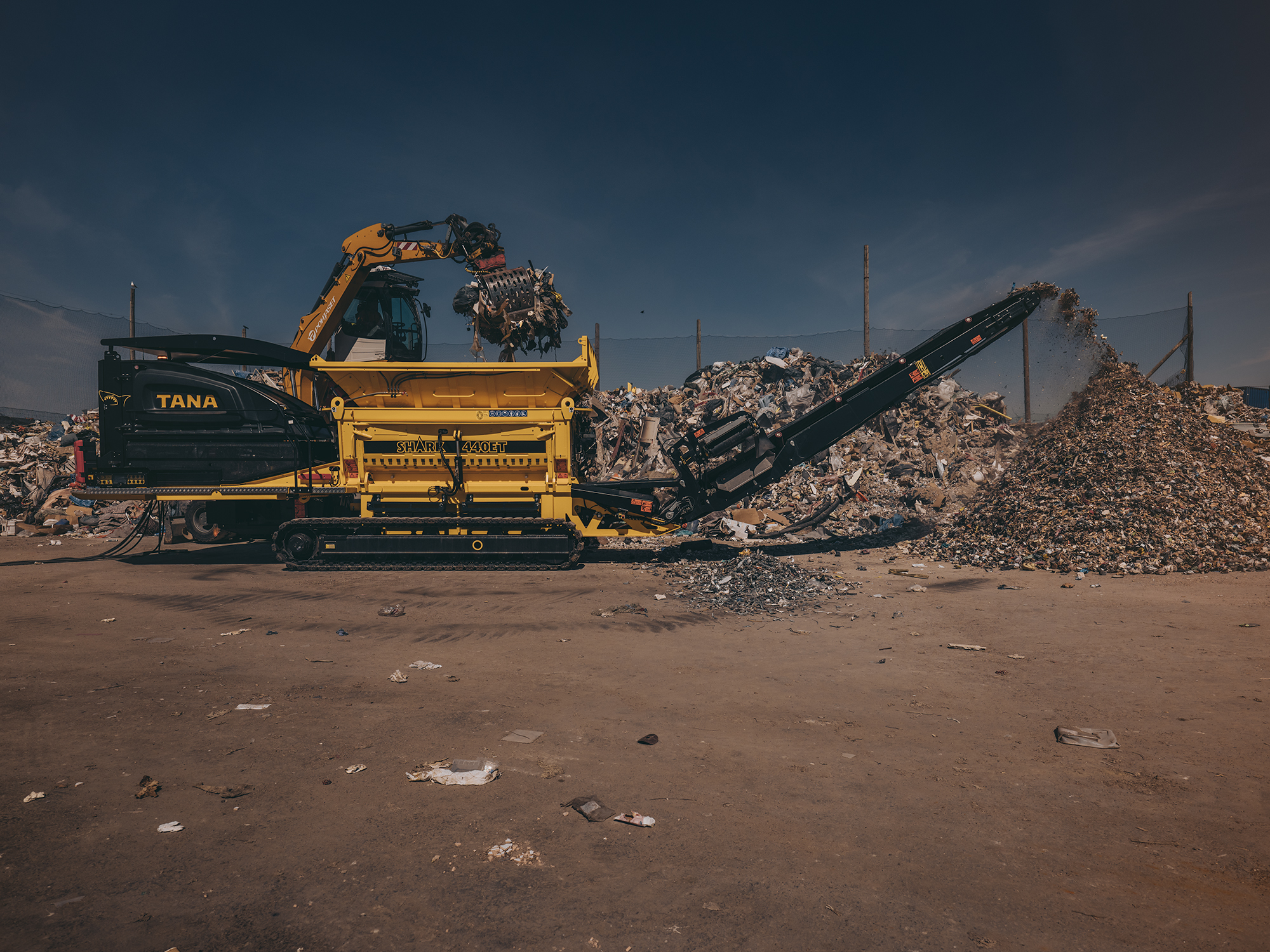
The construction and demolition (C&D) waste sector poses some of the most complex challenges within waste management, due to the sheer diversity, bulk, and composition of materials involved. Addressing these challenges is critical not only for operational efficiency but also for advancing environmental sustainability. Corbinian Gattermann, Key Account & Application Manager at Tana Oy, provides insights into the obstacles facing C&D waste management today and highlights how Tana’s advanced shredding technology is helping industries meet these demands.
Key challenges in C&D waste management
One of the primary hurdles in managing C&D waste is the vast quantity and range of materials involved, from concrete and metals to wood and plastics. “C&D waste is a mix of heavy materials like concrete, metals, and wood, often combined in a single load. Without the right equipment, valuable materials go to waste, recycling rates drop, and costs escalate,” says Gattermann. This complexity necessitates specialized machinery to handle diverse materials efficiently, as well as robust sorting and processing systems to reduce costs and maximize resource recovery.
Inadequate sorting at the point of origin aggravates these challenges, creating inefficiencies further down the line. “In my experience, mixed waste is often sent directly to the facility without enough on-site separation, which slows down processing and increases costs,” Gattermann notes. A more systematic approach to sorting, combined with flexible, adaptable equipment like TANA shredders, can dramatically improve productivity and reduce operational expenses.
Advanced sorting and shredding solutions
The TANA shredding solutions are specifically designed to address the complexities of waste such as C&D. In addition to being robust and versatile, the TANA Shark shredders, for example, feature the TANA Control System (TCS), which allows the operator to automatically adjust the rotor’s operation while handling tough materials like metal and concrete. This system prevents potential damage to the machinery, allowing for uninterrupted processing, even when handling challenging waste types.
The shredding process itself is streamlined for efficiency. “Typically, C&D waste is pre-sorted on-site and then fed into a TANA shredder for a single-pass reduction,” Gattermann explains. TANA shredders are customizable, with adjustable rotor and screen settings that allow operators to control output size from 50 to 500 millimeters. This versatility reduces processing time and energy consumption, making TANA shredders ideal for companies dealing with varied waste streams that require tailored solutions.
Enhancing resource recovery for sustainability
One of the standout benefits of TANA shredders is their contribution to sustainable resource recovery. “After shredding, we can recover valuable materials like metals, wood, and concrete. Metals are recycled, wood is repurposed for biofuel, and concrete is used as aggregate in construction projects,” Gattermann shares. By producing consistent particle sizes, TANA machines facilitate easier sorting and recycling, enabling companies to divert more materials from landfills and support a circular economy.
This approach not only reduces the environmental impact of C&D waste but also provides economic value through the recovery and repurposing of materials. By converting waste into usable resources, companies can meet sustainability goals and reduce landfill dependency.
Modular design and versatile power options
TANA shredders are distinguished by their modular design, which enhances flexibility and adaptability for processing various waste types. “Operators can adjust rotor and screen setups based on specific materials, which boosts processing speed and recovery rates,” says Gattermann. This adaptability allows for quick adjustments to meet the demands of different projects, saving both time and resources.
Additionally, TANA offers both diesel and electric-powered models to cater to different operational needs and sustainability objectives. Diesel models are suitable for remote or off-grid locations, while the stationary electric-powered TANA Shark 440E offers a zero-emission solution ideal for urban settings and environmentally sensitive projects.
Emerging trends and the future of Tana in sustainable waste management
As the C&D waste management industry increasingly adopts sustainable practices, Gattermann anticipates a shift toward equipment that prioritizes resource recovery and minimizes emissions. “Mobile and eco-friendly shredders are becoming essential as companies focus on on-site waste management and reducing their environmental impact,” he observes.
Tana’s commitment to efficiency and environmental responsibility places it at the forefront of this industry shift. With electric-powered shredders, advancements in modularity, and a focus on high recovery rates, TANA is positioned to lead the sector in helping companies meet recycling targets and align with sustainability goals.
Expert advice for companies looking to improve C&D waste management
Gattermann’s advice for companies aiming to enhance their C&D waste management is straightforward: invest in versatile machinery and prioritize systematic sorting. “Equipment like TANA shredders, capable of handling diverse waste types in a single pass, makes a significant difference in reducing costs and increasing recycling rates,” he advises.
As environmental regulations grow stricter and sustainability pressures increase, Gattermann sees Tana’s technology continuing to evolve with innovations that further reduce emissions and improve efficiency. With Tana’s expertise and adaptable machinery, companies can confidently address the challenges of C&D waste management while upholding high environmental standards.
In summary, Tana’s shredding solutions offer a comprehensive approach to managing C&D waste; boosting resource recovery, enabling SRF production, and supporting sustainable practices. For industries aiming to tackle complex waste streams, Tana represents a powerful ally in advancing operational efficiency and environmental responsibility.
